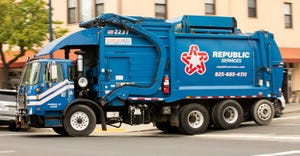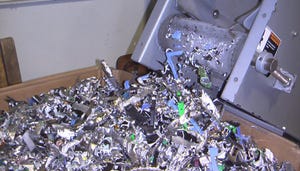Coping With Disappearing Paper Markets
October 1, 1996
Bill Moore
Recovered paper, the largest of the recyclable materials (as much as 75 percent by weight), has the most complex recovered material markets. The solid waste industry's two most important grades, old corrugated containers (OCC) and old newspapers (ONP), have been on a price rollercoaster for the last two years.
Starting at $18 per ton in January 1994, OCC reached two peaks in the Midwest at $110 per ton and $200 per ton before dropping dramatically in the second half of 1995. It ended the year at about $25 per ton (see chart on page 44). Substitution of mixed paper for OCC caused the prices to drop in late 1994.
Number 8 ONP, starting at $12 per ton in January 1994, rose steadily in the Midwest for 19 months, peaking at $165 per ton, before dropping to $40 per ton at the end of 1995. Since the beginning of this year, the grade has fallen even lower.
With this pricing volatility, neither buyers nor sellers can make any long-term, rational decisions about how to run their businesses.
The Variables The underlying products linked to OCC and ONP are containerboard and newsprint, respectively. These grades in the U.S. paper industry are mature commodity businesses; their prices are closely related to the industry's operating rates, which respond almost directly to changes in the U.S. gross domestic product. This is particularly true for containerboard, which is used to pack auto parts, construction materials and consumer products.
Although newsprint is linked to the general economy, it also is affected by long-range trends such as recycled newsprint content standards and a decline in newspaper readership.
The two linked variables - gross domestic product and newsprint/ containerboard pricing - account for most of the movement in recovered paper pricing. In early 1994, after three years of a sustained low price, containerboard mill operating rates and prices increased to historically high levels in the third quarter of 1995. From this all-time record, prices have fallen drastically, stabilizing only in the early part of this year's third quarter.
Similarly, newsprint product pricing, after being depressed from 1991 to early 1994, mounted sustained growth for almost the next two years. These prices, however, have been falling steadily since the beginning of this year.
The second most important set of variables in recovered paper prices includes recovered paper supply and new paper mill project demand, both domestic and export.
Prior to the mid-1980s, recovered paper was collected mainly through a "buy back" system where price was established and materials were bought "over the scale." As demand dropped, scale prices were lowered and supply diminished. With the increasing role of local governments and the waste industry in recycling, some of this self-correcting market mechanism was lost.
In fact, many people blame recycling legislation and the larger role of the waste industry for some of the paper markets' volatility. They point to the growing recovered paper supply that is not linked directly to demand. Over the past 20-year price history however, volatility during certain points of the paper industry cycle has been the norm.
The good news in paper recycling is that North American and world-wide demand has been growing at a rate twice as fast as the overall paper industry's growth in the last six years. This increased demand for recovered fiber is expected to continue over the next five years.
Collection/Disposal Costs Recycling legislation's major driving force in the late 1980s and early 1990s was the rapid increase in disposal prices throughout the United States. High disposal fees tend to generate more recovered paper and thus, lower prices. The importance of collection costs also are receiving attention in the waste industry. As we recover higher levels of material to feed the increasing demand, collection costs will increase rapidly.
Using OCC as a classic example, the easy-to-recover tonnages are all being recovered, and the collection cost is nominal. However, when an overall 70 percent OCC recovery rate forces us to collect OCC from small retail establishments, the collection cost will drive the material's price.
When recovered paper prices hit their peak in the last two years, paper makers sought lower priced fiber grades that were less than optimum.
Price Points It is useful to compare some generally accepted "break even" prices for recovered paper versus virgin wood fiber as a paper industry raw material. Although there are many variables involved in the decision to use virgin or recovered paper sources, it also is helpful to examine the rules of thumb used in the industry.
Once baled OCC reaches $120 per ton at the processing facility, virgin fiber becomes the less expensive choice. This price point is approximately $75 per ton for ONP. At prices above these levels, paper makers either will buy substitutes or change to virgin pulp, if they have the option.
If long-range prices are expected to be above these levels, new recycling projects probably will not occur. Complicating the ONP markets are the legislative and negotiated standards for recycled content, artificially affecting the price of the commodities.
When prices rise rapidly, manufacturers will use substitute paper grades. However, during the last two years, when OCC prices peaked and mixed paper was substituted, the grade's composition changed dramatically.
Because of demand, mixed paper, which only has small amounts of ONP, suddenly added significant quantities of old newspaper. This, in turn, slowed the growth in ONP supply used by the newsprint mills, and directly attributed to raising the ONP price.
Marketplace Volatility Recovered paper sales are one of the most informal, efficient commodity marketplaces in the world. It is also one of the more volatile of any material sold. For example, in July, 1994, when OCC prices hit its first peak of the decade, supply was less than 1 percent out of balance with demand. The OCC price quickly escalated.
Both suppliers and buyers agree that recovered paper prices are too unpredictable to make sound business decisions. And although the Chicago Board of Trade's project includes recovered paper prices, can this information affect hedging or futures? To date, the project has had limited successes; only a small amount of recovered paper is traded using this system.
In another attempt to come to terms with this market's volatility, users and producers of one of the finished products - linerboard (the major containerboard grade) have been meeting to draft a contract for futures trading of their commodity.
How should a hauler operate in unstable commodities markets? Link the sale price of your baled recovered paper to the price you paid for the material.
Agree to share the revenue with your government customer and link the whole program to ONP's marketplace pricing. When dealing in the private sector for grades such as OCC, be sure the sale price of the baled commodity is linked to costs of collecting the material.
Long-range, average price forecasting for recovered paper grades is possible using computer statistical modeling. Short-term pricing on a month-to-month or quarter-to-quarter basis is not possible because of changing inventory levels, weather and export markets. Extreme peaks and valleys cannot be accurately predicted using statistical modeling, but the long-range trends can be reasonably forecasted.
While recovered paper prices will always fluctuate, recovered paper is now part of the mainstream, worldwide pulp and paper industry. This can only lead to long-term, higher prices for recovered paper and the desire by both suppliers and users to stabilize the marketplace.
For further information, contact: Bill Moore, Moore & Associates, 8935 Ridgemont Dr., Atlanta, Ga. 30350. (770) 518-1890. Fax: (770) 518-2779. E-mail address: MA [email protected].
You May Also Like


